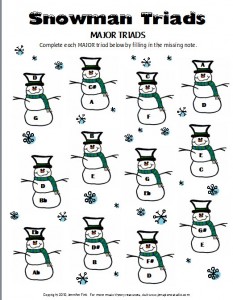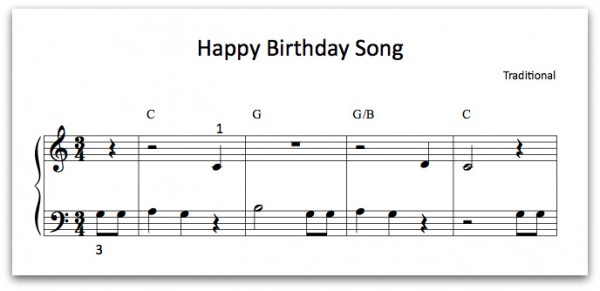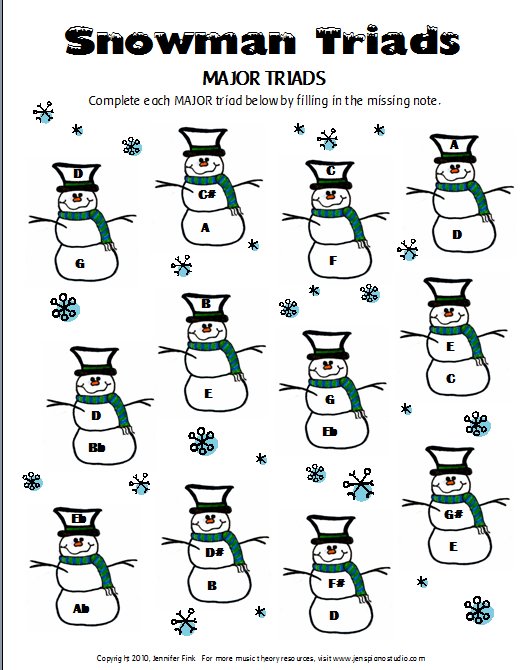 To follow up on my post from last week about my last group class (we call them “Piano Parties”), I wanted to share about the other two activities we did.
To follow up on my post from last week about my last group class (we call them “Piano Parties”), I wanted to share about the other two activities we did.
We started with this fun triad worksheet from Pianimation.com. This worksheet was a good reinforcement about what they learned from playing their major five-finger patterns, and was a good preparation for playing the 12-Bar Blues as a duet (as described in the previously-mentioned post).
Before playing the 12-Bar Blues, though, I had them playing the Happy Birthday song as a duet. I created a simple arrangement of the melody in Finale, with the chord symbols included above the staff.
I assigned the younger student to play the melody as written in the treble range of the keyboard, and instructed the other student to create a simple accompaniment by reading the chord symbols.

This was an excellent exercise in learning how to listen to each other! 🙂
I found out later that two of my students played the Happy Birthday duet for an older sibling’s birthday, a couple days later. What good timing! I think it is great for students to be able to play basic tunes like the Happy Birthday song for their families.
I also wrote an easy arrangement of “Twinkle, Twinkle, Little Star,” but we didn’t have time to use it that day. You can download both arrangements as free pdfs on the Printables > Sheet Music page.



Hey Joy! I’m thinking of starting piano group classes too. 🙂 What do your group classes do? I hold group theory classes but I’m thinking of holding other classes for younger kids, with a slightly different focus.
Every month, I hold a group class for my private students, mostly to develop camaraderie among my students. We cover a variety of rhythm and theory topics, mostly through games — but sometimes we do a composer lapbook from my shop or do a special activity like the duet/chord activity described in this blog post.
Cool, do you charge for these lessons? I would’ve loved group lessons as a student. 🙂
Nope, there is no extra fee for the group classes. When I set my tuition rates, I took into consideration the fact that I would have time/materials dedicated for monthly group classes. The classes are optional, so It’s up to parents whether they want to take advantage of the group classes or not. 🙂
Lovely! Something just clicked. I love that you’re there if they want to come and learn with the group. 🙂
So how do you decide when the group classes are, and what proportion of your students actually come? Do you have them RSVP beforehand?
I hold the classes on Saturday mornings from 10:30 to noon, once a month. It’s open to students ages 5-15, which is quite a range, I know. The 13-15 year olds that I have right now are all beginners to mid-intermediate students, so the range of levels isn’t actually that great. Eventually, I’d like to split things into two and offer something for more advanced students, but that will have to wait until I have enough intermediate-level students. I do ask students to RSVP sometime during the week so that I have an idea of how many worksheets to print, etc. Out of about 16 students who are of age to attend, I usually have between 6 and 10 students attend each time.
Love your site and am using it frequently. the “Happy Birthday song” is still under copyright – not traditional. thanks!
Actually, the lyrics are under copyright but the tune is not. The tune is much older than the lyrics and is considered a “Traditional” American folk tune, at least in my mind.
Thanks for your comment!
Hello, Joy! I’ve been thinking of a game to ride triads like your ice cream. Because here in Brazil snowmen are a distant reality, I made burgers! I would like to share it with you (you can access this link in my dropbox https://www.dropbox.com/s/2yr58vnbjkfj6jm/Br.pdf?dl=0 .) On the last page of the document there is an example. “Bread” on yellow papers and “stuffing” on red papers. I hope my collaboration is useful, and I like it!
What a great idea, Pietra, and the execution looks great!! Thanks so much for sharing your link.
Pietra, I think it would be great if you joined the Piano Teacher Funmakers group on facebook and shared your printable there! Link: https://www.facebook.com/groups/pianoteacherfunmakers/